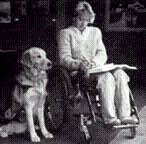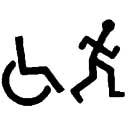 Print this page.
Print this page.
Man Upright, Large Brain

†††The evolutionary innovation that established hominids as a separate group from all other animals approximately 7.5 million years ago was bipedalism. This mechanical dynamic system that emerged not only enabled humans to walk upright but also set in place the mobile capabilities for this species to eventually engage in an unheard of range of activities compared to all other species on earth. Over 5 million years later, the other critical adaptation for modern humans was the development of a large brain. Anthropologists attribute the development of the brain throughout evolutionary history to have been brought about by a process of self-imbuing, that is, to have been shaped to construct an inner world appropriate to a speciesí daily life [1]. It is widely accepted that the more complex development of the brain has occurred, and still occurs, because of the sensory input the human brain receives from imagery, sound, touch, and reflective thought [1]. Today a single human life can learn to balance and whiz on a skateboard; to dive into water and swim competitive strokes; to climb a mountain and ride a bicycle; and then to use those same legs and feet to dance en pointe. Yet, along with evolution and the creation of efficient or novel environments, humans falter.
Man Falters
†††Spinal cord injury occurs in approximately 12,000 to 15,000 people in the U.S. per year due to such pursuits. 10,000 of the fortunate ones who survive are permanently paralyzed [2]. All face rehabilitation to some hopeful degree once the acute injury has healed and all come to rely upon assistive technology to help them gain control of their lives. Consequently, breakthroughs in health care themselves, in turn, create newer problems for scientists to resolve. One problem our society will be facing in greater numbers than ever before due to an aging population is stroke. As the third leading cause of death, stroke is the leading cause of

disability in America today. Approximately 700,000 Americans suffer from stroke each year. Of those who survive, the paralysis can be as devastating as from spinal cord injury 500,000 individuals face rehabilitation following a stroke [3]. Motor impairments are the most prevalent of all deficits after a stroke [4] and, therefore, a primary goal of rehabilitation is to improve limb function [5]. While the two conditions spinal cord injury and stroke differ in how the paralysis occurs at the molecular level, rehabilitation methods often overlap, along with the assistive technology available [6].
†††Such disablement not only affects individuals, but affects their families as well. According to the US Census Bureau,
the presence of a severe disability is associated with an increased likelihood of receiving welfare benefits, of having low levels of income, and being more likely to live in poverty."[2]
It is easy to predict, in accordance with our trend towards a rapidly aging society, [7] that the number of future stroke victims could place an unprecedented burden on our welfare system in years to come.
†††The most economical solution for society, as has been proven, is to restore the highest possible level of autonomy in affected patients [2, 8]. Yet, arriving at creative solutions in the laboratory is sometimes viewed as costly or risky enterprises even though such explorations retrospectively prove worthy. The medical

community and the government turn to scientists to determine long-term solutions that will eventually benefit the individual and society as a whole [9]. This student examination of rehabilitative assistive technology, for persons affected by spinal cord injury and stroke, is an attempt to understand the realm of issues scientists consider in order to resolve this dilemma of modern man that is, to project,
How best can we get man back on his feet when he has become disabled due to spinal cord injury or stroke?†

 disability in America today. Approximately 700,000 Americans suffer from stroke each year. Of those who survive, the paralysis can be as devastating as from spinal cord injury 500,000 individuals face rehabilitation following a stroke [3]. Motor impairments are the most prevalent of all deficits after a stroke [4] and, therefore, a primary goal of rehabilitation is to improve limb function [5]. While the two conditions spinal cord injury and stroke differ in how the paralysis occurs at the molecular level, rehabilitation methods often overlap, along with the assistive technology available [6].
disability in America today. Approximately 700,000 Americans suffer from stroke each year. Of those who survive, the paralysis can be as devastating as from spinal cord injury 500,000 individuals face rehabilitation following a stroke [3]. Motor impairments are the most prevalent of all deficits after a stroke [4] and, therefore, a primary goal of rehabilitation is to improve limb function [5]. While the two conditions spinal cord injury and stroke differ in how the paralysis occurs at the molecular level, rehabilitation methods often overlap, along with the assistive technology available [6]. community and the government turn to scientists to determine long-term solutions that will eventually benefit the individual and society as a whole [9]. This student examination of rehabilitative assistive technology, for persons affected by spinal cord injury and stroke, is an attempt to understand the realm of issues scientists consider in order to resolve this dilemma of modern man that is, to project, How best can we get man back on his feet when he has become disabled due to spinal cord injury or stroke?
community and the government turn to scientists to determine long-term solutions that will eventually benefit the individual and society as a whole [9]. This student examination of rehabilitative assistive technology, for persons affected by spinal cord injury and stroke, is an attempt to understand the realm of issues scientists consider in order to resolve this dilemma of modern man that is, to project, How best can we get man back on his feet when he has become disabled due to spinal cord injury or stroke?